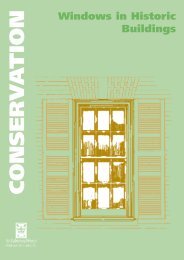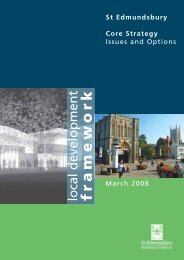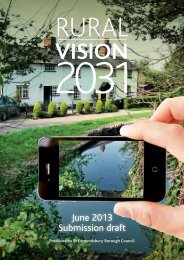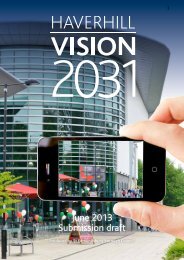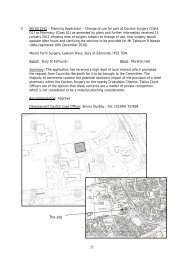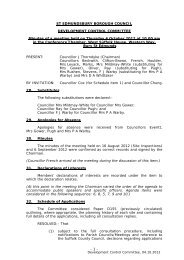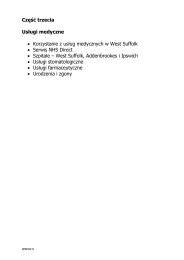St Edmundsbury Core Strategy (December 2010)
St Edmundsbury Core Strategy (December 2010)
St Edmundsbury Core Strategy (December 2010)
You also want an ePaper? Increase the reach of your titles
YUMPU automatically turns print PDFs into web optimized ePapers that Google loves.
Policy CS7 - Sustainable Transport4.84 The Government‟s long term strategy for a modern, efficient and sustainabletransport system was unveiled on the 20th July 2004 in „The Future of Transport‟White Paper. The strategy sets out a vision for;the road network providing a more reliable and freer-flowing service for bothpersonal travel and freight, with people able to make informed choices abouthow and when they travel;the rail network providing a fast, reliable and efficient service, particularly forinterurban journeys and commuting into large urban areas;bus services that are reliable, flexible, convenient and tailored to local needs;making walking and cycling a real alternative for local trips4.85 The East of England Plan (2008) includes the Regional Transport <strong>St</strong>rategy(RTS). This establishes a framework for the delivery of transport investment andpolicy priorities at the regional level which support the aims of the spatial strategy.The objectives of the RTS are to increase the number of travel movements bysustainable modes, such as walking, cycling and public transport. An objective isalso to enable the provision of infrastructure and transport services that arerequired to support existing communities and development proposed in the spatialstrategy.4.86 Measures are proposed for urban areas and Key Centres for Developmentand Change like Bury <strong>St</strong> Edmunds to reduce car dependency and bring a modalshift away from the car to alternative modes of travel. Bury <strong>St</strong> Edmunds is definedas a regional transport node in Policy T5 where priorities should be to improve theintegration of strategic and local networks, including the need to improve accessto rail stations and develop strategic park and ride sites.4.87 The Plan recognises the challenges faced by rural areas, like <strong>St</strong><strong>Edmundsbury</strong>, where reliance on the car, for many people, is essential due to thelack of transport alternatives.4.88 The Suffolk Local Transport Plan (2006-2011) contains local objectivestowards achieving a sustainable transport network. The problems of trafficcongestion in the market towns of Haverhill and Bury <strong>St</strong> Edmunds is noted, as isthe high number of daily vehicle movements passing through Haverhill due to outcommuting to Cambridge. The Plan acknowledges the economic importance ofBury <strong>St</strong> Edmunds within western Suffolk and that future development could belimited by increasing congestion at junctions on the A14. The implementationprogramme identifies specific objectives for <strong>St</strong> <strong>Edmundsbury</strong> including the need torelieve congestion in and around Bury <strong>St</strong> Edmunds town centre and improve publictransport, walking and cycling in the town. Whilst the rural areas are not sufferinga high level of congestion, many rural areas experience inappropriate traffic levelsand the associated noise, safety issues and visual impacts.4.89 The Bury <strong>St</strong> Edmunds Transport <strong>St</strong>rategy (2006) identifies the nature andscale of transport infrastructure required to support Bury <strong>St</strong> Edmunds‟ role as aKey Centre for Development and Change. The study undertook an assessment ofthe degree to which the capacity of the local transport network, particularly theA14 junctions, will limit future employment, service and housing growth in andaround the town. It identified that the town has few major transport problems butdoes have a considerable urban heritage to protect. It was concluded that the52




